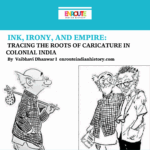Article Written By EIH Researcher And Writer
Yashvi Singh
The sound of the railway whistle, the hustle-bustle of the station and the gentle swaying of trains lulling us to sleep are all memories which are likely to be core in most Indians. We are the country which romanticised this British transport by portraying it in so many movies and in so far as to even climb on it to dance to one of the most memorable songs in Bollywood’s history. Trains remind us of family trips and playing cards with the cousins while the parents whipped up different combinations of the food brought from home, getting excited when you hear the vendor shouting “chai lelo, garama-garam chai” and gobbling it all up with the bread pakora we bought from the station. Train journeys are a fond nostalgic childhood memory which many Indians hold close to their heart but seldom would anyone have stopped to wonder about the origins of that very chai or cutlet or even the famous Railway mutton curry.
The railways were introduced by the British in India which was the running of its first stretch from Bombay to Thane in 1853 however, the introduction of food in railways was a later occurrence. Eastern Indian Railway’s Allahabad-Jabalpur branch became the first train in 1870 to have an entire cabin dedicated to a restaurant. Before this, some stations were earmarked with refreshment rooms where orders were placed on the train itself (the order was believed to be taken by the Ticket Examiner but can’t be ascertained) and food was ready when the train arrived. The halt time in these refreshment stations was appropriately long to facilitate passengers having their meals peacefully. There were different refreshment rooms for Europeans, Muslims, vegetarian Hindus and non-vegetarian Hindus.
It was these refreshment rooms which were called the ‘clandestine spaces for experimentation’ as people came far from their ‘respectable’ families to indulge in otherwise socially unacceptable behaviours like drinking alcohol or eating meat.
The story of the famed Railway Mutton curry is one such story of hybridization in which a indian dish was modiied to better suit the british palette. The story goes- a British officer travelling on the Frontier Mail back in early 1900s wandered into the train pantry following the aroma of spices in search of a midnight snack. Mangsho Jhol, what the bengalis lovingly called their mutton curry, was never a part of first-class cuisine which usually included things like jelly puddings or badami shorba. Mangho Jhol itself was believed to be inspired from Wajid Ali Shah’s mutton korma which also utilized cooking methods like stir frying spices and grinding it into a powder before using it in the dish. However, in the absence of anything else, the pantry cooks offered him the masala-filled mangsho jhol which proved to be too spicy for him. The panty cooks, which were no less than self-styled ‘bawarchis’, tried to add cream and yoghurt to it to make it most suitable for the British gentlemen. The officer liked it so much that he had the same dish every time he boarded the train.
The railway mutton curry finally became this yellow watered down, milder version of the Indian mutton curry which allowed the colonials to enjoy the fragrant and sharp Indian masalas without the added hassle of a burnt stomach. This dish is actually a lovely fusion of English spices like bay leaves, cloves, pepper, cinnamon, cardamom and Indian elements such as cumin, turmeric, ginger, garlic, red chilies, etc. As the Railway Curry became a favourite among the passengers, the pantry cooks started standardising the recipe and even experimented with various spices and agents to make it mild like coconut milk. Soon, they realised that the best way to serve the dish was to finish it right in the pantry itself and add the cream right before serving it by adding and mixing it slowly so that it doesnt curdle in the heat. They also added aromatics like cumin to intensify the flavour.
This style of curry disseminated not only in India, but all over the Empire in the form of British cookbooks and most importantly, officials who were transferred to different divisions of Great Britain. Even the celebrated Indian cook-book author, Madhur Jaffrey who once said that ‘curry’ is a term as degrading to Indian cuisine as ‘chop suey’ is to Chinese, later published a book ‘The Ultimate Curry Bible’- indicatiing the pervasiveness of the word.
Even the origin of the term ‘curry’ has many explanantions, each more contested than the next. Perhaps it was derived from the south Indian languages in which ‘karil’ denoted a spiced dish of sauteed vegetables and meat. Or perhaps it was derived from the Portuguese ‘caril’ used to describe broths made with butter, the pul of Indian nuts and spices like cardamona and ginger. Regardless, in English it was adopted as ‘curry; and used to denote a variety of Indian dishes which is still used by Indians themselves now.
Similarly, the veg cutlet is another culinary modification of Indian borrowing from the British. The French ‘cotelette’ became the Bengali ‘kaalet’ in the hands of seasoned Anglo-Indian cooks employed by the British. It was Lord Amherst who started the cultivation of potato in India, whose saplings he bought and planted first in Barrackpore. The British employed French cooks who adapted their traditional cuisine, usually made with veal or pork into a thinly covering chicken breast carving to better suit British taste. The intermingling of cuisines could also be attributed to marriage alliances between aforementioned parties. Regardless, the chicken or potato cutlet was a hit among the British and Indians alike and was thus transported to the Railway Colonies and mining towns from where it became a staple in the railway cuisine. Its suitability and appropriateness in this context is perhaps the reason why even after many swadeshi movement-associated changes in the railway menu, the cutlet has is still part of their breakfast offering.
The railway food is perhaps half the reason why the railway experience is as quintessential and nostalgic as it is. Every offering on the menu is backed by decades of effort, story and most importantly, history. This familiarity and comfort is perhaps the reason why even today, people prefer to take the train and spend quality time with their families even in the presence of other, perhaps more convenient options.
Bibliography
- Sen, Colleen Taylor. Curry: A Global History. Reaktion Books, 2009.
- Collingham, Lizzie. Curry: A tale of cooks and conquerors. Oxford University Press, 2006.
- Panjabi, Camellia. The great curries of India. Simon and Schuster, 1995.
- Dhawan, Vijay. Food and Beverage Service. Frank Brothers, 2000.
- Chatterjee, Arup K. The Great Indian Railways: A Cultural Biography. Bloomsbury Publishing, 2019.
- Isha Doshi. “View of Food and Language as Markers of Identity: The Anglo Indian Community’s Survival Since Partition.” The International Journal of Anglo-Indian Studies, vol. 11, no. 1, 2011, pp. 16–36.
















